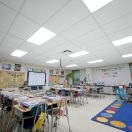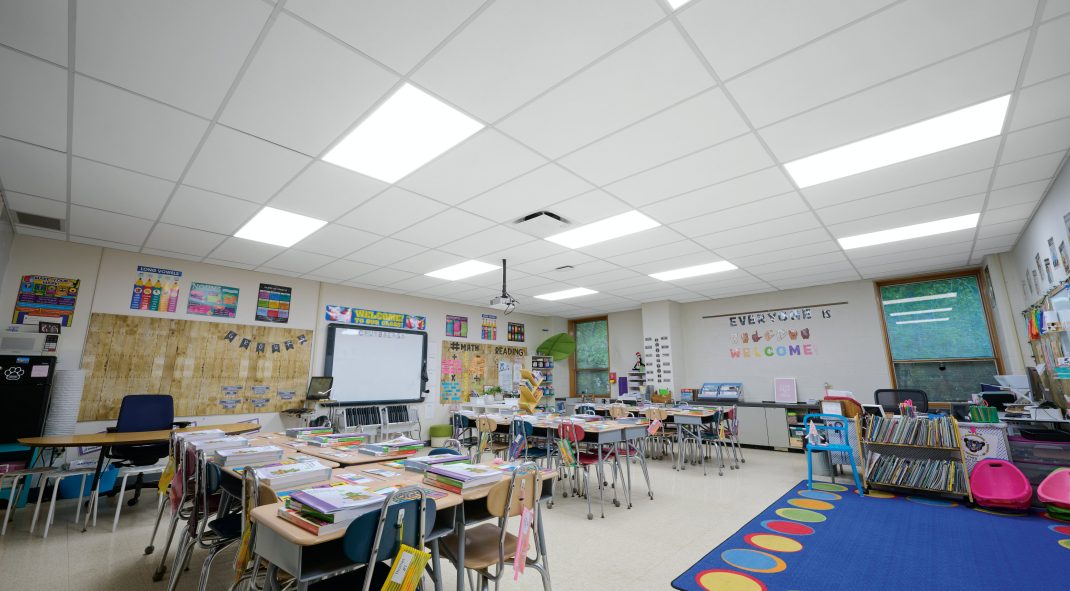The Challenge:
Indoor air quality (IAQ), acoustics, and lighting in school buildings affect students’ ability to learn and the overall health of all building occupants. In addition, poor IAQ leads to higher absenteeism, and poor acoustics are linked to lower test scores.
To ascertain the quality of its indoor environmental quality (IEQ), the Panther Valley Elementary School in Nesquehoning, PA recently placed AWAIR indoor environmental sensors throughout the school. The sensors measure seven key IEQ factors: temperature, humidity, CO2, volatile organic compounds (VOCs), particulate matter (PM2.5), noise, and light.
During initial monitoring, the overall indoor environmental AWAIR scores moved between fair and good, averaging in the low 80s. Air quality issues identified as primary areas of concern were ventilation rates and light levels. Secondary areas of concern included CO2 thresholds, noise, and thermal comfort levels.
The Solution:
To help address these concerns, the school replaced the ceilings in a 780-square-foot third-grade classroom and a 450-square-foot nurse’s office. Built in the 1980s, the classroom houses 27-32 students and is in use nearly eight hours a day.
ULTIMA high light-reflective ceiling panels from Armstrong Ceiling & Wall Solutions were installed in both spaces. The smooth-textured panels with a non-directional visual are both washable and impact-and-scratch-resistant.
An in-ceiling Armstrong STRATACLEAN IQ Air Filtration System was also installed in the classroom to improve indoor air quality. The system captures and removes 90% of airborne contaminants, allergens, and other particulates using proven MERV 13 filtration.
An internal fan draws air through one side of the grille. The air then moves through a MERV 13 filter and discharges back into the space through the opposite side. One unit can filter the air in a 1,000 square foot space every hour. With the fan running, air in the occupied space is constantly filtered to provide clean, purified air.
Like many schools in the northern part of the country, Panther Valley Elementary has no (or limited) HVAC system. As a result, air changes per hour (ACH) in the classroom were only .5 ACH. Following installation of the StrataClean unit, ACH increased to 1.5 ACH. Increasing ACH helped reduce exposure to airborne contaminants. In addition, particulate matter and CO2 levels decreased.
Third grade teacher, Tori Koerbler, noticed the improvement. As she says, “I know how important indoor air quality is for both myself and my students. I’m a severe asthmatic and I haven’t had any episodes since the start of school and the room renovation.”
In addition, an Armstrong VIDASHIELD UV24 air purification system was installed in the nurse’s office. This unit operates by continuously drawing air into a self-contained chamber in the ceiling plenum where the air is treated safely with ultraviolet light air-cleaning technology. The cleaner, disinfected air then circulates back into the room reducing occupant exposure to viruses and bacteria.
Third-party testing shows this system neutralizes 97 percent of infectious pathogens on the first pass of air through the system. This contributes to healthier spaces by minimizing allergy and asthma triggers and by reducing the level of other infectious pathogens in the air and the settling of those pathogens onto room surfaces.
The new ceiling panels provided improved lighting as well. Estimated light reflectance value of the existing ceiling was in the 40 – 60 range, while the ULTIMA ceiling panels have a light reflectance of 88.
By upgrading to ULTIMA ceiling tile and new LED light fixtures, light levels in the spaces more than doubled from 116 to 253 lux. Improved light reflectance brightens spaces, maximizes light, and enhances visual comfort by reducing eye strain and glare.
The acoustic environment also improved. The Noise Reduction Coefficient (NRC) of the ceiling increased from .55 to .75, meaning the new panels absorbed 75% of the sound that strikes them. The new ceiling panels also provide Armstrong TOTAL ACOUSTICS performance, meaning they not only absorb sound but also block it from entering adjacent spaces.
Following completion of the improvements, AWAIR scores were in the mid 80s to low 90s with an average near 88.
Commenting on the improvements, principal Rob Palazzo states: “Coming out of COVID, it’s important we continue to explore what’s next for air quality in the building. The cafeteria could be the next space. As far as the future, we will continue to regard improved indoor environmental quality as a long-term investment.”
Director of Buildings and Grounds, Scott Fisher concurs: “Improved indoor air quality is especially important since we have no full-blown HVAC system in the building. The cleaner, brighter environment definitely has an effect on how kids learn.”
And, in addition to improved indoor air quality, third-grade teacher Koerbler notes “The classroom is so much brighter, making it easier for students to see things. Even parents noticed the difference during parent/teacher night.”
Project: Panther Valley Elementary School
Location: Nesquehoning, PA
Products: ULTIMA ceilings



